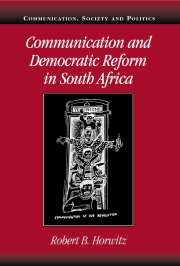Book contents
- Frontmatter
- Contents
- List of Tables
- Preface and Acknowledgments
- List of Acronyms and Abbreviations
- 1 Introduction and Overview
- 2 The Ancien Régime in the South African Communications Sector
- 3 “Sharing Power without Losing Control”: Reform Apartheid and the New Politics of Resistance
- 4 “Control Will Not Pass to Us”: The Reform Process in Broadcasting
- 5 “All Shall Call”: The Telecommunications Reform Process
- 6 Free but “Responsible”: The Battle over the Press and the Reform of the South African Communication Service
- 7 Conclusion: Black Economic Empowerment and Transformation
- Appendix
- References
- Index
6 - Free but “Responsible”: The Battle over the Press and the Reform of the South African Communication Service
Published online by Cambridge University Press: 04 December 2009
- Frontmatter
- Contents
- List of Tables
- Preface and Acknowledgments
- List of Acronyms and Abbreviations
- 1 Introduction and Overview
- 2 The Ancien Régime in the South African Communications Sector
- 3 “Sharing Power without Losing Control”: Reform Apartheid and the New Politics of Resistance
- 4 “Control Will Not Pass to Us”: The Reform Process in Broadcasting
- 5 “All Shall Call”: The Telecommunications Reform Process
- 6 Free but “Responsible”: The Battle over the Press and the Reform of the South African Communication Service
- 7 Conclusion: Black Economic Empowerment and Transformation
- Appendix
- References
- Index
Summary
The final reform process in the communications sector revolved around the South African Communication Service (SACS), the state bureaucracy that performed information functions and had long served as the apartheid government's public relations mouthpiece. Like so many other institutions in the immediate post-apartheid period, SACS was targeted for transformation. Indeed, there was sentiment for eliminating the service entirely. The organization was seen by many as irredeemable, its mission regarded as an anathema in a now democratic polity. Others saw SACS as an important means to disseminate the new government's policies. But should a democratic government have an official information service? The debate over the fate of SACS after 1994 was a fight, in complicated fashion, over the vision of the post-apartheid communications system. In some respects that vision had already been decided along the way, albeit in piecemeal fashion. Broadcasting, as we have seen, would be a mixed system of three levels: a public service broadcaster formally independent of political control; a limited domain of commercial broadcasting with significant local content obligations and black shareholding; and locally controlled community radio – all overseen by a constitutionally mandated Independent Broadcasting Authority. In the telecommunications sector, the Green Paper/White Paper consultative reform process envisioned a majority state-owned Telkom, but infused by foreign shareholding capital, it would take on the task of expanding the telephone network to the previously disadvantaged as a responsibility fixed in its license.
- Type
- Chapter
- Information
- Communication and Democratic Reform in South Africa , pp. 282 - 322Publisher: Cambridge University PressPrint publication year: 2001

